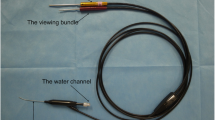Abstract
Purpose
To evaluate the effect of postoperative nasal triamcinolone spray use in primary endoscopic dacryocystorhinostomy using The Lacrimal Symptom Questionnaire.
Methods
This study included a series of 50 consecutive retrospective cases with primary endoscopic dacryocystorhinostomy and with silicone stent implantation who were followed up for 6 months postoperatively. Patients using nasal triamcinolone spray for 3 months postoperatively were included in the triamcinolone group. Patients not using triamcinolone were included in the control group. Lacrimal stents were removed 3 months postoperatively. The Lacrimal Symptom Questionnaire (Lac-Q) was performed in the preoperative and postoperative 6th month. Anatomical success, functional success, and changes in lacrimal symptom and social impact scores were compared between the two groups 6 months after surgery.
Results
Results of 48 endoscopic dacryocystorhinostomies performed on 48 patients (23 triamcinolone group, 25 control group) meeting the inclusion criteria were analyzed. The anatomical success rate (95.7% vs. 84.0%, p = 0.350) and the functional success rate (91.3% vs. 76.0%, p = 0.249) were higher in the triamcinolone group, but this difference was not statistically significant. No complications were observed in the triamcinolone group, whereas complications developed in two patients in the control group (p = 0.490). The mean change in total lac-Q score was 11.0 in the triamcinolone group and 9.0 in the control group (p = 0.011). The mean change in social impact score was 4.0 in the triamcinolone group and 3.0 in the control group (p = 0.005). Mean change in lacrimal symptom score was 6.0 in the triamcinolone group and 6.0 in the control group (p = 0.368)
Conclusions
Our study indicated that postoperative use of triamcinolone spray increases the success rate of endoscopic dacryocystorhinostomy and also revealed that triamcinolone may also lead to greater improvement in quality of life scores than the control group using a validated questionnaire.



Similar content being viewed by others
Data availability
The datasets generated during and/or analyzed during the current study are available from the corresponding author on reasonable request.
References
Harish V, Benger RS (2014) Origins of lacrimal surgery, and evolution of dacryocystorhinostomy to the present. Clin Exp Ophthalmol 42:284–287. https://doi.org/10.1111/ceo.12161
Leong SC, Macewen CJ, White PS (2010) A systematic review of outcomes after dacryocystorhinostomy in adults. Am J Rhinol Allergy 24:81–90. https://doi.org/10.2500/ajra.2010.24.3393
Keren S, Abergel A, Manor A et al (2020) Endoscopic dacryocystorhinostomy: reasons for failure. Eye (Lond) 34:948–953. https://doi.org/10.1038/s41433-019-0612-y
Côté DW, Wright ED (2010) Triamcinolone-impregnated nasal dressing following endoscopic sinus surgery: a randomized, double-blind, placebo-controlled study. Laryngoscope 120:1269–1273. https://doi.org/10.1002/lary.20905
Sabarinath V, Harish MR, Divakaran S (2017) Triamcinolone ımpregnated nasal pack in endoscopic sinus surgery: our experience. Indian J Otolaryngol Head Neck Surg 69:88–92. https://doi.org/10.1007/s12070-016-1041-x
Vento SI, Blomgren K, Hytönen M et al (2012) Prevention of relapses of nasal polyposis with intranasal triamcinolone acetonide after polyp surgery: a prospective double-blind, placebo-controlled, randomised study with a 9-month follow-up. Clin Otolaryngol 37:117–123. https://doi.org/10.1111/j.1749-4486.2012.02455.x
Kang TS, Won YK, Kim JY et al (2021) Efficacy of triamcinolone-soaked nasal packing on endoscopic dacryocystorhinostomy. Ophthalmic Plast Reconstr Surg 37:44–47. https://doi.org/10.1097/iop.0000000000001791
Jo A, Lee SH, Song WC, Shin HJ (2018) Effects of ostium granulomas and intralesional steroid injections on the surgical outcome in endoscopic dacryocystorhinostomy. Graefes Arch Clin Exp Ophthalmol 256:1993–2000. https://doi.org/10.1007/s00417-018-4024-7
Ali MJ, Wormald PJ, Psaltis AJ (2015) The dacryocystorhinostomy ostium granulomas: classification, ındications for treatment, management modalities and outcomes. Orbit 34:146–151. https://doi.org/10.3109/01676830.2015.1014510
Mistry N, Rockley TJ, Reynolds T, Hopkins C (2011) Development and validation of a symptom questionnaire for recording outcomes in adult lacrimal surgery. Rhinology 49:538–545. https://doi.org/10.4193/rhino11.042
Ali MJ, Iram S, Ali MH, Naik MN (2017) Assessing the outcomes of powered endoscopic dacryocystorhinostomy in adults using the lacrimal symptom (Lac-Q) questionnaire. Ophthalmic Plast Reconstr Surg 33:65–68. https://doi.org/10.1097/iop.0000000000000660
Wong WK, Dean S, Nair S (2018) Comparison between endoscopic and external dacryocystorhinostomy by using the lacrimal symptom questionnaire: a pilot study. Am J Rhinol Allergy 32:46–51. https://doi.org/10.2500/ajra.2018.32.4494
Vinciguerra A, Nonis A, Resti AG et al (2020) Impact of post-surgical therapies on endoscopic and external dacryocystorhinostomy: systematic review and meta-analysis. Am J Rhinol Allergy 34:846–856. https://doi.org/10.1177/1945892420945218
Phelps PO, Abariga SA, Cowling BJ et al (2020) Antimetabolites as an adjunct to dacryocystorhinostomy for nasolacrimal duct obstruction. Cochrane Database Syst Rev 4:CD012309. https://doi.org/10.1002/14651858.cd012309.pub2
Do JR, Lee H, Baek S et al (2016) Efficacy of postoperative mitomycin-C eye drops on the clinical outcome in endoscopic dacryocystorhinostomy. Graefes Arch Clin Exp Ophthalmol 254:785–790. https://doi.org/10.1007/s00417-015-3229-2
Wright ED, Agrawal S (2007) Impact of perioperative systemic steroids on surgical outcomes in patients with chronic rhinosinusitis with polyposis: evaluation with the novel perioperative sinus endoscopy (POSE) scoring system. Laryngoscope 117:1–28. https://doi.org/10.1097/mlg.0b013e31814842f8
Funding
No funding was received for conducting this study.
Author information
Authors and Affiliations
Contributions
All authors contributed to the study conception and design. All authors read and approved the final manuscript.
Corresponding author
Ethics declarations
Conflict of interest
The authors have no relevant financial or non-financial interests to disclose.
Consent to participate
Informed consent was obtained from all individual participants included in the study.
Consent for publication
Patients signed informed consent regarding publishing their data and photographs.
Ethical approval
This study was performed in line with the principles of the Declaration of Helsinki. Approval was granted by the Ethics Committee of Ordu University Medical School (Date: 2021/No: 116).
Additional information
Publisher's Note
Springer Nature remains neutral with regard to jurisdictional claims in published maps and institutional affiliations.
Rights and permissions
About this article
Cite this article
Kaptı, H.B., Korkmaz, H. Evaluation of the efficacy of postoperative triamcinolone in endoscopic dacryocystorhinostomy using lacrimal symptom questionnaire. Int Ophthalmol 42, 2573–2580 (2022). https://doi.org/10.1007/s10792-022-02305-6
Received:
Accepted:
Published:
Issue Date:
DOI: https://doi.org/10.1007/s10792-022-02305-6




